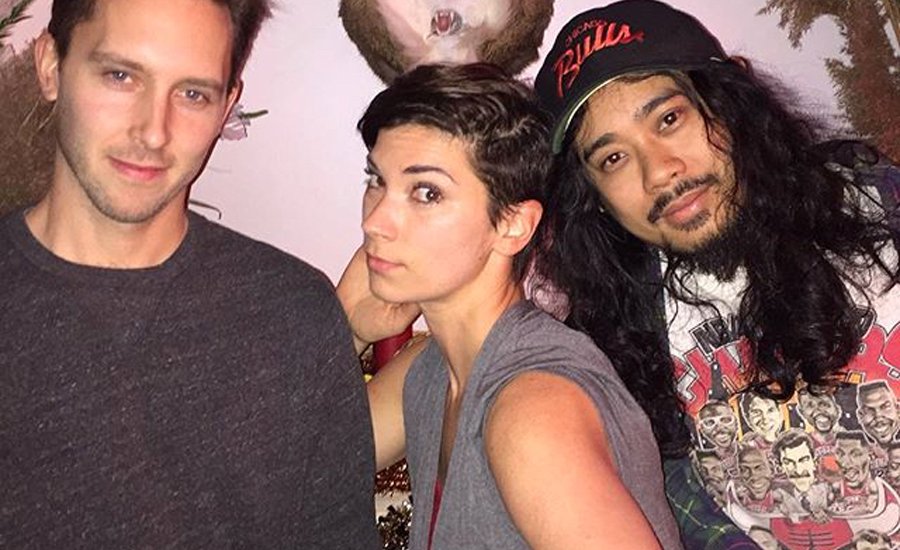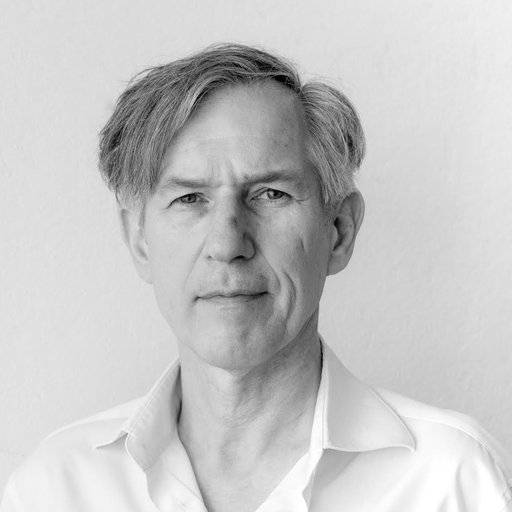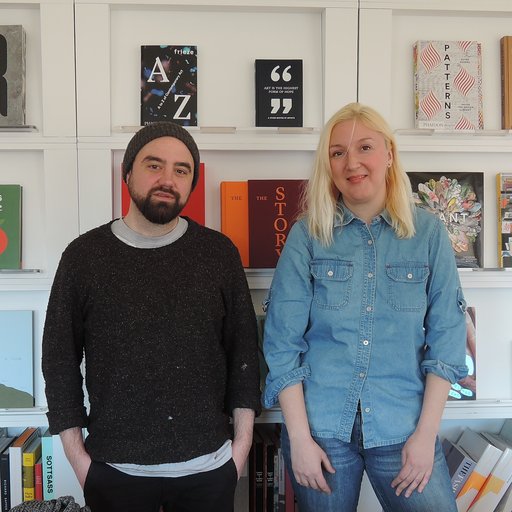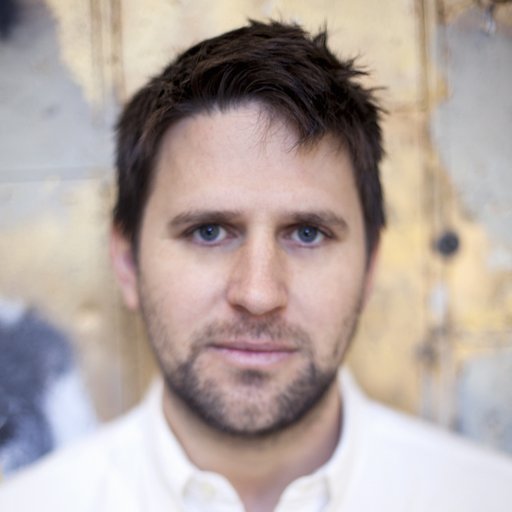Journalists and art critics are always looking for the next scoop. And although galleries and museums might seem like the obvious places to scout emerging trends and conversations, let’s be honest: real talk flows most freely with a drink in hand, or more specifically, a vodka-spiked Club-Mate at Beverly’s, an artist-run bar at the heart of the downtown New York art scene on Essex and Hester.
Started in 2013 by artist Leah Dixon, Dan Sutti, Chris Herity, Gabe Schulman, Leah Malone, and Suvi Lehtinen, Beverly’s narrow, hole-in-the-wall space quickly became the social epicenter of the Lower East Side’s art and fashion enclaves. Advertising almost-nightly DJs and dance parties via campy, Y2K-nostalgic promo-images on Instagram, the bar is crammed nightly with cool-kids looking to break a sweat.
But although Beverly’s is the go-to destination for gallery opening after-parties, its stake in the art world is more than just an after-thought. With a rotating bimonthly exhibition program, the bar installs wall pieces on its neon-lit walls, video art on its television screens, and sculptures on its bar. Before you roll your eyes, this isn’t the artsy coffee shop on your block that claims to do the same thing. Artists who show at Beverly’s probably wouldn’t dream of exhibiting at ordinary bars and restaurants—artists like Jayson Musson, Artie Vierkant, Cristina Tufiño, Roxanne Jackson, Joshua Citarella, Hein Koh, and Jesse Greenberg are just few of the many heavy-hitting artists to exhibit at the bar. (Full disclosure, this writer exhibited her work in collaboration with artist Johnny Stanish at Beverly’s in 2013.) On view currently is the work of Philip Ashley and Alva Calymayor.
Here, Artspace’s editor-in-chief Loney Abrams talks with founding partner Leah Dixon, who bartends occasionally at Beverly’s, about what artists, writers, and curator’s really talk about after hours, about fostering a “living room” for members of the LGBTQ community and the political left, about the safety hazards that come with running a neighborhood bar in tense and violent times, and about eradicating the nasty “art bar” stigma.
How would you describe the Beverly’s crowd?
The Beverly’s crowd is very political, always. It is people who are very conscious of their place in history, whether they're artists, younger people who work in fashion, or simply people who just want to know what’s going on in nightlife—the kind of people that make it their business to go out every night. I think they view their engagement in nightlife as a form of stamping a time in New York history.
Then a lot of writers, curators, gallerists, and creative people in general make up a part of the crowd. And it changes; you see waves come and go. Now I would say that we get a lot of artists, writers, and curators who don’t live in New York. They come in and say, “I live in London and everyone said make thisyour first stop,” or “I live in Hong Kong and I’m coming here.” So the circle has expanded outwards.
I think I told you this story before, but I took some out-of-town friends to Beverly’s on New Years Eve. We had a blast and when we left, my friend turned to me and said, “That was so much fun! I didn’t realize we were going to a gay bar!” I hadn't really thought to characterize Beverly's as a "gay bar," but I can see why she said that. Does her perception surprise you? Is the queer scene a big part of what Beverly’s is about?
Absolutely. The queer scene is very integral to our crowd. The Lower East Side is still the Lower East Side—I know from personal experience how dangerous the neighborhood still is. So we very intentionally made the bar bright! We made it visually dynamic. We want people to come here out of positivity and curiosity. We do not want to attract people who are coming to forget their lives and hide in a dark corner. Our branding and design choice was very purposeful at the beginning, but then it definitely spiraled and people have really made it their own. So much of Beverly’s now isn’t even what we made it; it’s what it has become. And specifically, many queer kids, who I think have always been incredibly integral to Manhattan nightlife, have really taken it and made it their own.
As somebody who spends a lot of time at the bar talking to people, can you tell me if there are certain topics or issues that come up again and again conversationally?
People definitely talk about class a lot, which might be partially because Beverly’s is very inexpensive for Manhattan, and so maybe it attracts a certain kind of person. You certainly don’t go there to be fancy, and feel like you’re dropping hundreds—you kind of couldn’t do that even if you wanted to.
People have always talked about identity politics, too. I think that is how nightlife has always played a huge role; it’s always been ahead of the conversation about identity politics because it forges actual, genuine social relationships. Being so small and intimate, people don’t go to Beverly’s and stay in their friend clique. They go there to meet other people. Everyone opens up there, which I think does kind of lend itself to having these conversations.
Also, a couple of years ago people were always talking about the art market, but I think that has just died a little bit everywhere. But for a while, people would definitely go there and talk about the market, which is funny because in a way our model is in direct opposition to that.
How has the election influenced conversation?
Beverly’s was always so pro-Bernie Sanders. Bernie was what everyone was talking about. I mean, Trump couldn’t be further away from why Beverly’s exists. People are fucking pissed. After the election it was interesting to see the amount of people who wrote emails or Facebook messages to my partners and I saying, “Thank you for making a home for us, and a place where I know I don’t have to worry or feel scared and I can always be myself and feel supported.” The day after the election it was like a kind of church for people in there. There’s a community of people who have banded together, using Beverly’s as a living room and a place to have discussions about what’s going on politically.
Because you as an individual are very outspoken politically, and have a very outspoken social media presence, it’s hard not to project that attitude onto Berverly’s—at least for me. I associate Beverly’s with an activist spirit that I think has become part of its brand. From a commercial standpoint, it’s not always advantageous to align a business with a political movement or perspective because you’re going to alienate a group of people, potential customers. But I guess for a place like Beverly’s, a bar, where you’re customers aren’t making anonymous e-commerce sales or something, but are actually sitting two feet in front of you for hours at a time, it makes sense to alienate the people you aren’t particularly interested in getting to know.
Yes, in terms of a social structure, it’s very self-policing. People genuinely stand up very vocally. First of all, it’s very loud in there, so you have to be a certain person to desire that atmosphere. And it’s definitely a place that requires you to multi-task because it gets so crowded, it’s hot, there’s art, there are performances, there are DJs, and so much going on at once. It requires a very high level of engagement. Beverly’s is not a small group of people that want to come and chitchat quietly amongst themselves; we would rather have people that show up ready to open up. So I think the idea that it’s a space that fosters a level of activism is actually who we are, in a way.
Not too long ago there was a crime sparked by politics that happened right next door, is that right?
Yes.
What happened?
My partners and I were in Mexico for Material Art Fair and we found out about it after the fact. At the time of the incident we were closed; we are only open until two o’clock. There was basically a group of people at the bar next door who chased, beat up, and stabbed two guys for having anti-fascist propaganda. This criminal incident has been a giant topic of conversation amongst my partners and my employees.
It’s not a surprise for people who have worked in bars for a long time, but I think what’s a surprise to a lot of people is that truly anyone can walk in off the street. There is a level of danger that is present inside all bars at all times. And that realization really shook us out of any level of safety we had felt. Since it’s so bureaucratic to have a liquor license, we are in constant conversation with our police precinct; all bar owners are. We’re really aware of our responsibly to the safety of the neighborhood. We have security guards at Beverly’s but the bar next door did not. We made sure that they do now.
Do you feel that because Beverly’s is so outspoken politically that you’re a target? Do you feel any pressure to tone it down for the sake of your customers’ safety?
No, not at all. I think so many people have taken ownership over Beverly’s at this point because they spend so much time there or are so visible in its identity. As long as someone’s politics are positive and inclusive, I am not interested in ever creating a space that would make people feel like they would ever have to be quiet or diplomatic for the sake of my business.
Let’s switch gears and talk a little bit about Beverly’s model. How did Beverly’s start?
Beverly’s started when the bar that I worked at called Sweet Paradise, which was on Orchard and Canal, got bought out. It was this amazing bar that existed right when the Lower East Side was starting to have a lot of galleries open. This was in 2010-2011—the post-financial-collapse era of the Lower East Side when spaces where cheap. Back then, a lot of people where doing after-parties for gallery openings at Sweet Paradise, and I was the head bartender. When the bar got bought out, all of the bartenders who worked there lost their jobs. Bartending was my main source of income; I was making art and showing art all the time, but bartending was how I made my money.
It hit me eventually that with Sweet Paradise closing, there needed to be a new bar: something that fused the necessity of the service industry in that neighborhood with what was at that point the up-and-coming art scene. I started talking to some people who were also customers at Sweet Paradise about this idea. Then my first two partners (there are six of us now) and I decided to move forward. Between that bar closing, which was in the winter of 2012, to Beverly’s opening in winter 2013, was a full year. We worked that year getting investments, taking on our other partners, getting our liquor license, doing community outreach, conceptualizing it, designing it, getting all of our building permits—all the bureaucratic craziness. And, we basically did all the building ourselves. It was a year of full-time work before Beverly’s actually opened.
Beverly’s is an art bar in that it hosts an art crowd, but it also exhibits art. Was Sweet Paradise operating this way as well?
No, it wasn’t an exhibition space. But there really wasn’t anywhere to go down there at that time that had an art crowd. At first, when Sweet Paradise opened around 2006, it had a kind of a Max Fish crowd, like a very skater crowd. As the Lower East Side and especially Chinatown East Side began changing, the crowd changed. I was doing a lot to get gallery after-parties coming in. That was my social circle anyway. Then when it closed there was this hole that I could see needed to be filled. Being an artist and long time bartender, and having managed bars always in the Lower East Side, I asked, “Who better to start this than me?”
I also was saddened by the fact that many artists feel the need to hide their day jobs. We all know that if we are not one of the very privileged few, we must work. With Beverly's, we wanted to show the importance of nightlife workers in driving the circulation of creative content. We wanted to celebrate this labor. And we wanted artists to experiment within this context.
Even as a bunch of first-time business owners, my partners and I were pretty sure that we would be busy from the first day we opened because in addition to artists, we could just grab onto that Sweet Paradise crowd that had nowhere to go. Our crowd has changed a lot since then, but in that first year we had a very similar crowd to the originals from Sweet Paradise.
How did the decision to exhibit art come about and how would you describe your exhibition model? Do you have monthly exhibitions?
We have them about six times a year, and then we do off-site projects twice a year, generally. Being an artist myself made me realize that artists’ work could be engaged with in this other way. Immediately when we knew we wanted to open the bar, we designed it around the idea that it needed to be flexible or neutral enough to work with a rotating exhibition program. I couldn’t understand why the stigma existed around showing in semi-public/private spaces that were non-galleries.
Basically our curatorial model is simply, “Who are artists that are interested in certain things that should get to know each other?” It’s like social curating, completely. This is what is happening in a bar or a nightlife venue anyway in terms of what parties and events and DJs are being booked. We’re just adding the extra element of visual artists in there. And it’s worked great.
How? There are “art bars” and “art cafes” all over New York and all over the country that try to do the same thing, but an artist who actually had a shot at a career, or who shows in the LES or Chelsea, would never want to show at those places. How do you think you were able to convince artists to be involved?
Straight up: personal relationships. Personal relationships helped a lot in the beginning and then later we were able to leverage our reputation. I also think the location has always helped us because a lot of curators and writers are always in there. Since day one, they’ve been a lot of the meat and the potatoes of our crowd.
I do think the stigma is changing, and I think people are becoming more open to the idea of an “art bar.” I mean, we certainly are not trying to sell the art; we’re not a gallery. I don’t ever sit at my computer and do outreach to collectors. What we offer is simply a longer-term engagement that people can have with the work. And I think that’s something that artists are curious about.
What would happen if someone were in a room with a work, the room was functioning on many different levels, and the person was there for five hours? The audience engages with the work in a very different way at 8 o’clock versus midnight. And the exhibitions mark time, too. I think this is one of my favorite parts about how programming works at Beverly’s—people who come to Beverly’s say things like, “Remember when that one thing happened here? It was during Hein Koh’s show.” Art marks time. The engagement with the work is so layered and I think a lot of artists are interested in playing with that.
And let’s be honest, Beverly’s gets a lot more foot traffic than gallery spaces, so exhibiting artists will benefit from a lot more eyes.
Thousands and thousands, literally!
You’re not really engaged in the market because as you said you’re not cultivating collectors and you don’t sell work, but you do have a relationship with Material Art Fair in Mexico City. Is Material the only fair that you do?
We did the Untitled Art Fair in 2013, our very first year.
Why do you do fairs?
In every fair we’ve actually partnered with the fair, in that they've asked us to do a special project. We’ll be part of their VIP programming, for example, and we never actually run the bars or do pop-up bars—we just do programming. I think that’s advantageous for the fair because we bring this party element to it, and we can also bring hard or risky work that a lot of galleries couldn’t afford to show during an art fair because they’re trying to make sales. We don’t have those constraints. Also, because we are often given these giant spaces, we’ll bring fifteen artists—so we foster this social dynamic between the artists we bring that helps cultivate a temperature for the fair. In the case of Material, we’re friends with the owners, who are also young business owners and are bridging this alternative entrepreneurial model. They’ve been a dream to work with.
What do you guys get out of it?
We love the chance to do programming outside of our bar and it creates a memorable experience. At this point there are probably 60 to 70 artists that we’ve worked with on these off-site exhibitions. They have forged relationships with each other, made friends with all these people, and that directly feeds back into the social dynamic that we require in order to operate.
To wrap up, are there any events or plans that Beverly’s has on the horizon?
There are always things cooking in terms of programming. In early April we are programming a segment of the Brooklyn Academy of Music Gala. We’re going to set up the bar to make it look sculptural and interesting. Then we’re going to program a few different artists to exhibit within the space. This is actually our third time working with BAM, but this will a bigger version of what we’ve done with them before. It came about just through knowing Holly Shen. She’s a curator who I’ve worked with personally before, and she’s also the Visual Arts Curator at BAM.
Right now, we’re also in the process of re-signing our lease—so what we hope is that Beverly’s is going to be around for a lot longer.
























